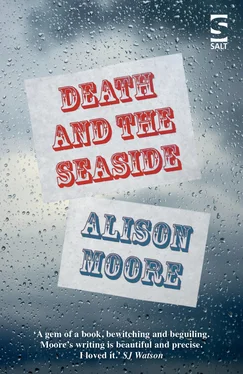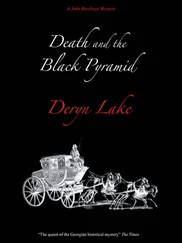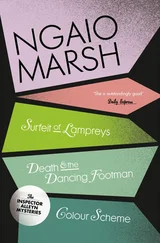The screen faded to black.
Apparently there were other versions as well, but Bonnie was wary of seeing them.
She did not feel like going to bed just yet. She changed channels and watched an old silent film, the start of which she had already missed. Intertitles flashed up, like subliminal messaging for slower readers: ‘What’s the matter — afraid of Temptation?’ Or like a fortune cookie message: ‘The only way to get rid of a temptation is to yield to it.’ The flickering text also reminded her of an installation that she had seen with her mother at Tate Liverpool: in a dark box of a room, she had sat on a bench facing a screen on which a short black and white film had looped, and in amongst the indistinct, ghostly images she had seen a phrase, ‘THE DEATH OF TOI’. She had sat there watching the film of flickering light and shadows repeating, the words flashing up over and over again. She had been comfortable in there. It was not often she went to a gallery, and less often still that she understood a piece of modern art, but this, she felt, she did. She was talking about it as they left the gallery, and her mother said, ‘I don’t think that’s what it said. Didn’t you see the description?’ Bonnie had not. The film, her mother explained, was a corrupted recreation of the final scene of the silent film of Uncle Tom’s Cabin , and the caption was ‘THE DEATH OF TOM’. Bonnie had seen something that was not really there, or rather, she had seen something that she was not meant to see. Now that she had seen it, though, she could not unsee it; she still saw it flashing up on the screen in her mind’s eye as she walked with her mother up Water Street: ‘THE DEATH OF TOI’.
The film that Bonnie was watching now came to an end: ‘ The End ’ appeared on the screen and Bonnie switched the television off. She made another cup of tea and took it to bed with her.
On Sunday afternoon, Bonnie went to the launderette. There was no one in there except for her, and the woman behind the counter who was in charge. There were machines going, but most people put their washing in and then left, and came back when their washing was done. Bonnie, though, had once put her washing into the machine and gone home and failed to return until after the launderette was closed. Now she stayed, to be on the safe side.
She put her washing into a machine and set it going. The woman behind the counter said, ‘Hello, love,’ and Bonnie turned around. The woman was not looking at her now; she was searching through a bag of laundry. Bonnie said hello but she might have said it too quietly to be heard; the woman did not look up. Bonnie sat down to wait. She had forgotten to bring a magazine. Her phone was in her pocket but she had neglected to charge it and the screen was dead.
The launderette had been given a fresh coat of paint; Bonnie could smell the fumes. The smell reminded her of ghosts. She had once — three times in fact — seen the ghost of Elvis Presley. She had been asleep in her bedroom, which was being painted at the time, the walls changing from a floral pattern to plain white, the blue flowers still showing through after the second coat, like the bell on Noddy’s hat showing through the black paint on Adrian Mole’s bedroom wall, the bell iterated dozens of times around the walls and still showing through coat after coat. Bonnie had woken up in the night and seen Elvis’s ghost, which came forward out of a poster of him, which was still up on a wall that had not yet been painted, or else — she could not remember — the wall had already been painted and the poster had been put back up. The following night, the same thing happened, except that this time Elvis grew bigger, came closer. On the third night, he was bigger and closer still, a beautiful spectre looming over her. She did not tell her mother, who would have said that it was only the paint fumes. Bonnie knew that it was not just the paint fumes: she had seen it with her own eyes.
Bonnie watched her washing tumbling around inside the spinning machine. It was mesmeric. It made her feel sleepy.
The woman behind the counter said, ‘You have to watch this programme they’re showing at nine o’clock tonight on the BBC.’
‘Oh,’ said Bonnie. ‘All right.’
The woman glanced up, and Bonnie realised that the woman was using a hands-free device; she was talking to somebody else.
‘Sorry,’ said Bonnie. ‘You were talking to somebody else, weren’t you?’
‘Yes,’ said the woman, but she had already looked away again and her reply might have been meant for the person on the other end of the phone.
When the washing machine came to a stop, Bonnie discovered that she had not brought enough money for the drier, and besides, the afternoon had disappeared and the launderette would be closing soon. She pulled her wet washing out of the machine into her Bag for Life and lugged it home. She draped her damp laundry over the washing line in the yard, and it hung there in the early evening shadows and in the dusk, barely drying at all, while Bonnie flicked between BBC channels, wondering which of the nine o’clock programmes was the right one.
My subjects knew me as Dr Slythe. I had put an advertisement in the local paper, and a reasonable number of people had responded. I hired an upstairs room in a community centre on Waterside Close. The room was not one of those windowless boxes: it had a large window, which I opened, and I pinned a welcoming notice onto the door. I set up a television and a video player and put out a row of chairs for the participants. It was going to be, I thought, a little bit like one of those theatre shows where you think you’re just in the audience but then, unexpectedly, you have become part of the performance, sometimes without even leaving your seat. The houselights go up and that’s the signal, like the light which comes on before the meat powder is delivered into the dog’s dish in Pavlov’s experiment, or like the tone which the dog hears prior to receiving a shock in Rescorla’s investigations, or in Maier and Seligman’s experiments, which showed that dogs which have been taught through conditioning that they have no control over receiving shocks will, in the second stage of the experiment, when they do have a choice, make no attempt to avoid the shock.
I dressed the part, in a suit, navy blue, and I also had a white laboratory coat to wear, which I had borrowed from the university prior to being asked to leave.
My subjects were split up into three groups, each of which was to be shown a video which I had put together in the editing suite. Nowadays, there is dedicated software: I could do it on my laptop at home.
I was planning on testing the power of subliminal messaging, not by flashing up the name of a branded drink or even an exhortation to drink this particular branded drink. It seemed to me that the success of such an experiment would be hard to quantify: a participant who, after seeing the video, chose that particular branded drink, might have chosen it anyway, regardless of the subliminal message. It seemed much more reasonable to assume that nobody coming into the room that day was planning on jumping out of the window.
More specifically, I was aiming to establish which was the more effective: negative suggestion or positive command. I had, in the editing suite, put together three videos. Superficially, they were all the same, a montage of various everyday images.
My morning cohort, Group A, included Mrs Falls. She’d had to bring along her daughter, who was seven years old at the time. The little girl sat on the floor at the back of the room with a drawing pad and some felt-tip pens and a packet of sweets to keep her quiet. “Don’t draw on the floor, Bonnie,” said Mrs Falls to the little girl, who had not yet uncapped a pen. The little girl looked at the floor, whose vinyl tiles were about the same size and shape as the sheets of paper in her drawing pad, and she took the lid off a pen. I seated my participants so that they were facing both the television screen and, beyond it, the window, which was open, I said, so that the room would not be stifling. I explained to them that I was studying attention span and memory, and that they were required to watch very closely the video which I was about to show to them, and that afterwards there would be a task and questions. And so, they watched very closely a video in which I had planted messages which appeared on the screen for a matter of milliseconds. For Group A, in amongst landscape and cityscape and seashore shots, there were positive commands: “FAIL”, in capitals in white on black and in black on white, and “JUMP”, superimposed on edges, ledges, open windows. (“Fail” is both a positive command and a negative word. In a 2009 article, “Subliminal advertising really does work, claim scientists”, the Telegraph reported that subjects who were shown negative, neutral and positive subliminal words were more likely to pick up, subconsciously, on the negative ones, such as “despair”, and “murder”.) When the video came to an end, I realised that I had forgotten to put on my white laboratory coat. I put it on and then asked the participants to take a buzz-wire test. There was a reasonable success rate on the buzz-wire test, which was a disappointment. Mrs Falls managed it: she had a very steady hand. I then asked a series of questions about the video which the group had been shown, keeping them there for longer than I had planned to, but not a single person showed the slightest interest in the open window. I was not, of course, planning on letting anyone actually jump out of the window, but the urge to do so would nonetheless have been evident. I had argued with the university many times about such subtleties.
Читать дальше












